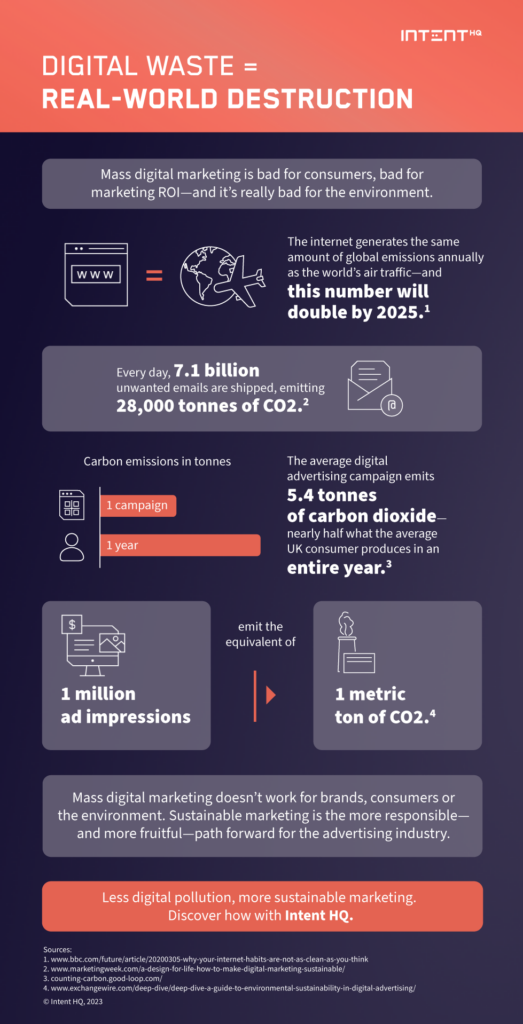
eBook: Intent Edge – The Superpower of Super Apps
Super Apps are redefining the digital landscape, blending multiple services into one seamless platform. Explore how they’re creating new pathways for user engagement and business growth.

The marketing world is growing more aware—and more worried—about the negative impacts of mass marketing. Ad Net Zero found that 71% of marketers are concerned about the environmental impact of the industry, and according to Good-Loop, almost 90% of marketers believe the industry has a responsibility to reduce carbon emissions generated by digital advertising. While this seems like a promising sentiment, the same Good-Loop report found that nearly 47% of marketing professionals have no plans to reduce the carbon emissions generated by their campaigns.
Thankfully, there is a better way forward. Sustainable marketing is a strategy focused on reducing the environmental impact of traditional print marketing and the oft-unrecognized dangers of digital pollution and data waste by centering smart, focused and streamlined marketing efforts. It kills two birds with one stone—reducing the environmental impact of the advertising industry and improving a company’s marketing ROI.
Sustainable marketing can be woven into a broader corporate social responsibility strategy and its benefits are multifold. It enables companies to spend resources efficiently, create a higher impact among their audience, reduce their carbon footprint, distinguish themselves as sustainability trailblazers and inspire brand loyalty. Sustainable marketing is a more responsible path forward for the marketing industry—and it’s the only way to truly reach your audience in a noisy, overwhelming marketing landscape.
We’ve all filtered out spammy brand emails, thrown away seemingly endless junk mail, and scrolled past click-bait Instagram ads. Though this irrelevant marketing may seem environmentally negligible compared to say, plastic production or air traffic, marketing pollution has a serious impact on the environment. The 100 billion pieces of junk mail delivered annually generates 51 million metric tons of greenhouse gasses, adds 1 billion pounds of waste to landfills and wastes up to 56% of media budgets. Every day, 7.1 billion unwanted emails are shipped, emitting a whopping 28,000 tonnes of CO2. The internet generates the same level of global emissions as the world’s air traffic— and experts predict that number will double by 2025.
In this new era of personalized customer experiences, consumers don’t have patience for brands that treat them all the same or annoy them with nonstop ads. Think of the coveted Super Bowl ad spot, which cost 7 million dollars this year—though the sports event is widely considered the pinnacle of advertising reach, a study by Communicus found that up to 80% of Super Bowl ads don’t drive sales. When these mass campaigns don’t reach the right audiences, you’re not only creating marketing pollution—you’re also wasting your own time and money.
Digital pollution can also harm your data collection and analytics efforts. Storing old or duplicated information leaves you with a weaker understanding of your customers based on inaccurate and bloated data, obscuring potential opportunities. Around 20% of the data in the average dataset is bad, and MIT estimates that bad data costs the average company up to 25% of annual revenue.
By neglecting to regularly maintain customer data architecture, you also waste money on data storage and increase your company’s energy usage and technical debt. McKinsey found that technical debt can account for up to 40% of a company’s IT budget. When companies utilize weak data sets to determine the scope, shape and tone of their marketing efforts, they end up emailing digital ghosts, delivering unnoticed ads, and sloppily contacting audiences they don’t understand. According to Marketing Week, only 9% of digital ads are viewed for more than a second, and a Forrester study found that 21% of marketing budgets are wasted due to poor data quality. While the financial ramifications are bad enough, it’s important to remember that these marketing misfires have deep environmental impacts, too.
Sustainable marketing strategies help your campaigns generate real leads and reduce your company’s carbon footprint. So, what does it look like in practice? Here are three key tenets:
Sustainable marketing is a vital part of mitigating the impact digital marketing is having on the planet—and it’s good business sense too. It’s a win-win-win strategy for brands, consumers and the environment. Implementing a sustainable marketing strategy is a necessary step for companies seeking to expand their digital reach, gain authentic audience engagement and keep the planet safe.
